Written by Sgt. Joe Padula
2nd Brigade Combat Team PAO, 101st Airborne Division
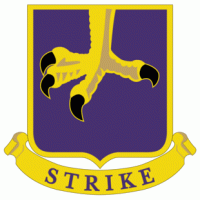
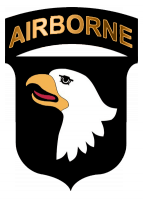 Fort Campbell, KY – “Fire in the hole! Fire in the hole, Fire in the hole!” screams a combat engineer, then the sound of a soft click leaves his hands and then a deafening boom; a secured doorway is no more.
Fort Campbell, KY – “Fire in the hole! Fire in the hole, Fire in the hole!” screams a combat engineer, then the sound of a soft click leaves his hands and then a deafening boom; a secured doorway is no more.
A combat engineer, also known as a Sapper, is a Soldier who performs an array of construction and demolition duties under combat conditions. They are trained in constructing and breaching trenches, building bunkers, creating tank traps and fortifications, constructing and/or demolishing bridges, roads and now perhaps most commonly known as the guys who cleared land mines and IED’s from routes in Iraq and Afghanistan.
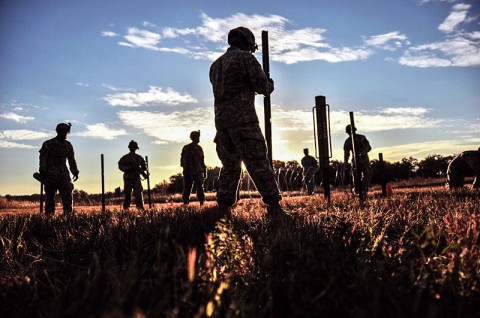
“The Sapper Stakes is a validation of all of the hard training the companies, platoons and squads have done over this past year, in addition to everything they have done to prepare for potential deployments,” said Sgt. Maj. Darren Oliphant, the engineer sergeant major with the 101st Airborne Division (Air Assault).
“Engineer units rarely get to see other engineers and events like this bring them all together and allows them to show their competency, their regimental pride and their brotherhood.”
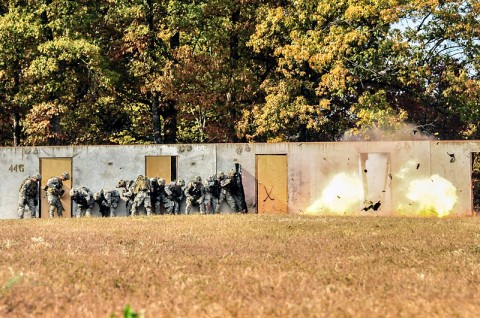
The two-day competition began with a non-standard Army Physical Fitness Test comprised of pull-ups, push-ups, sit-ups and a two-mile ruck-run. Then the teams conducted a mile and a half full combat load run and completed a standard air assault obstacle course. Then from the air assault course, performed an air assault mission in a UH-60 Black Hawk helicopter into the training areas, where the competitors began their three-mile road march towards the awaiting testing lanes.
Once at the training lanes and still wearing a full combat load, the combat engineers were tested on conventional demolitions, basic engineer knowledge, emplacement of obstacles and charges, the construction of fighting positions, IED identification, urban breaching detonations, first aid in a combat zone, their knowledge of the Army’s weapon systems that led to the firing of weapons under stressful conditions. The diverse testing lanes displayed the many rolls of a Sapper and shows their capabilities reach far beyond just route clearance operations.
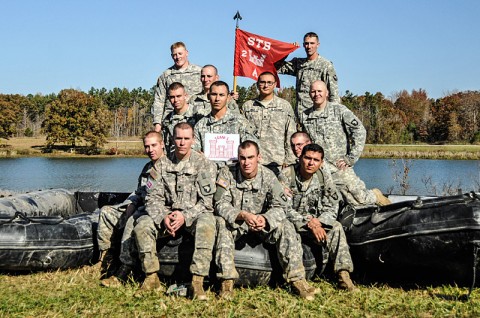 “This is about basic combat engineering skills,” said Lt. Col. Patrick Kinsman, commander of Sapper Eagles, the 326th Engineer Battalion, while breathing heavily due to his running at the side of Team Sapper Eagles, whose finished the competition in a close second. “During all the different rotations and deployments to Iraq and Afghanistan, the deployed Sapper units were mostly performing route clearance and some of the basic Sapper tasks haven’t been done in a while. Now we are getting back to the basic factors and common tasks.”
“This is about basic combat engineering skills,” said Lt. Col. Patrick Kinsman, commander of Sapper Eagles, the 326th Engineer Battalion, while breathing heavily due to his running at the side of Team Sapper Eagles, whose finished the competition in a close second. “During all the different rotations and deployments to Iraq and Afghanistan, the deployed Sapper units were mostly performing route clearance and some of the basic Sapper tasks haven’t been done in a while. Now we are getting back to the basic factors and common tasks.”
After the testing lanes were completed, the teams waited until dark and performed on a night land navigation course. When the sun began to rise the following morning, the competition was hours away from completion.
 The final event had the teams run through a four-mile combat focused physical training course where they carried tactical equipment such as full water jugs, weighted medical liters and large inflatable rafts.
The final event had the teams run through a four-mile combat focused physical training course where they carried tactical equipment such as full water jugs, weighted medical liters and large inflatable rafts.
Awaiting at the Sapper Stakes finish line with medals, plaques and words of accomplishment was Command Sgt. Maj. Terrence Murphy, the command sergeant major of the Engineer Regiment out of Fort Leonard Wood, Missouri.
“The things that you did this week, I would cherish,” said Murphy while in front of all the teams. “If you are standing here today you have proven you have the physical stamina to be a Sapper and you have the mental capacity; you are Sappers, the best regiment in the Army and that regiment is proud of you.”


















